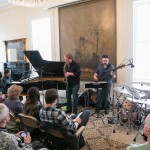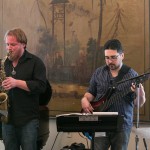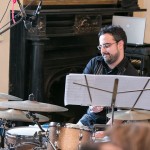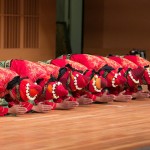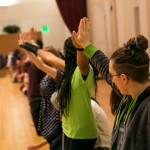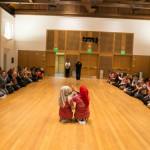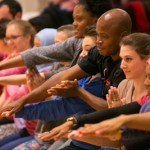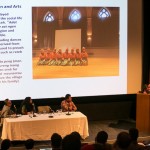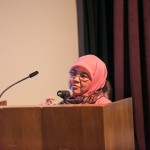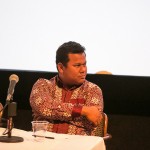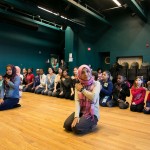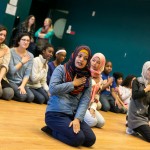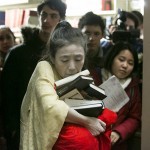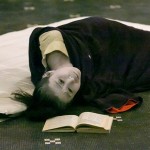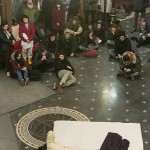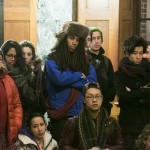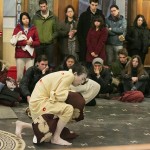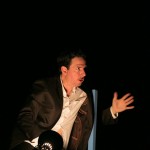CFA Arts Administration Intern Chloe Jones ’15 talks to singer-songwriter Omnia Hegazy, who performs with her band this Friday, March 27, 2015 at 8pm in Crowell Concert Hall as part of Muslim Women’s Voices at Wesleyan.
You began writing lyrics for your first EP on a trip to Egypt in 2010. What about the trip inspired you to start writing?

I tend to take a notebook with me and scribble wherever I go, and it was the summer before [Hosni] Mubarak was overthrown, so everyone was talking about politics all the time. I was staying in a youth shelter at the time and talking with other Egyptians about what was going on and writing down my observations about how women are treated, about things I felt were unfair in the culture. These are things that I grew up with in America, as well—people take their culture with them. So I started writing things down and not necessarily as an outsider because these things do exist in America too. These inequalities are not just among Egyptians but everybody.
What inspired your second EP, Judgment Day?
I wrote this song after watching a film called The Stoning of Soraya M, based [on] a true story about a woman in Iran who was stoned because her husband framed her for adultery. This actually happened in the 1980s. I was so upset by the film that I wrote a song, not so much about the film, but about what is happening to people of my faith. It was a critique about how I feel some people of my faith have taken religion and made it so evil and how it can really harm people. The song became the title track of the EP.
Judgment Day is a provocative title. What does the title mean to you?
I feel that as a Middle Eastern woman, there is a lot of judgment. We face a lot more judgment than our male counterparts. Our reputation is our biggest asset in a lot of cases. The title was about that feeling of constantly being judged. I feel like every day is judgment day for an Arab woman, a Muslim woman. Everyone else is judging what you should do, what you should say, what you should sing. That’s what I tried to address with the title and specifically with that song.
You say you might have been a journalist, had your life gone a different direction. Thinking about journalism and songwriting as two forms of storytelling, what do you think song achieves that journalism does not?
For me, writing a song can appeal to people’s emotions in a way that hard news just can’t. Often people just want to turn the news off because it’s so depressing, but with song one can elaborate behind whatever story you’re telling to make people really feel. It’s not just the facts, not just what happened. I think the reason song is so effective is that it helps creates empathy in a way that sometimes hard news just doesn’t.
What do you hope people will gain from listening to your music?
I want to make people think. I want people to have a good time, but there’s a lot of music out there that doesn’t necessarily really make people think. To be fair, I think that all music has a place. I don’t think you have to address an issue for the music to be important, like the stuff I’m writing now is more about personal things. I think that’s just as important because I think songwriting attempts to reach an understanding about the human condition. I want people to feel something when they listen to my music. Whether I’m writing about a break up or political evil, I just want them to feel something.
Do you think your songs fall into either a personal or political category, or do you think both the personal and the political are manifest in each song you write?
To me the two are intertwined. How I feel about any given issue is political, and it’s personal. I’m observing, and I recognize that there’s bias in my music. I wouldn’t see it as hard news, so much as an op-ed. It’s personal and political. One of my newer singles that just came out is very personal. It’s about street harassment, about being a woman and feeling unsafe. That is actually something political—there’s a feminist message in the song, [and] it’s talking about the place of women in society—but it’s very personal.
Who are some of your greatest musical influences?
One of the biggest is a singer from Columbia named Juanes. He’s a pop/rock singer-songwriter and a mean guitar player. He’s actually the best selling artist in Columbia, even before Shakira. But if you listen to his older stuff, he was using really catchy melodies to write really meaningful things. He has one song that is so catchy you want to bob your head to it, but then you really listen to it and realize he’s talking about landmines. He made me realize that pop music is actually a really useful vehicle to spread a message, and it doesn’t have to be esoteric or metaphorical to be political. Other than Juanes, I’m influenced by the 1960s—any of the singer-songwriters of the 1960s. Also, India.Arie. She writes some really catchy songs, but there’s a good message behind them. She has soul. I like artists with consciousness, not just political consciousness but any kind.
Omnia Hegazy
Friday, March 27, 2015 at 8pm
Crowell Concert Hall
$18 general public; $15 senior citizens, Wesleyan faculty/staff/alumni, non-Wesleyan students; $6 Wesleyan students
At Wesleyan, Ms. Hegazy will be accompanied for the first time outside of New York City by drummer Max Maples, bassist Carl Limbacher, electric guitarist Coyote Anderson, and Natalia Perlaza on Arabic percussion and tabla.



